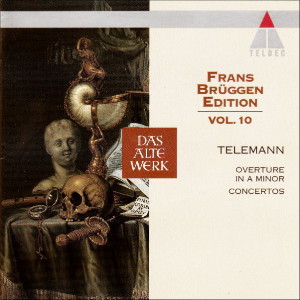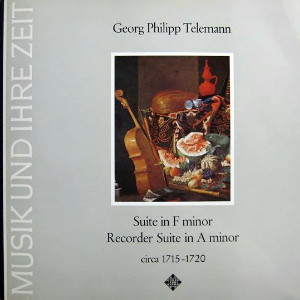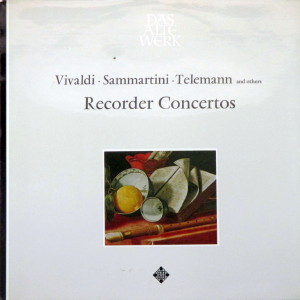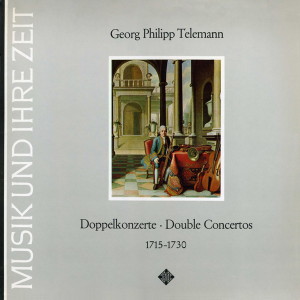 |
|
1 CD -
4509-97472-2 - (c) 1995
|

|
| 1 LP -
SAWT 9507-A - (p) 1967 |
 |
| 1 LP -
SAWT 9533-B - (p) 1968 |
 |
| 1 LP -
SAWT 9483-A - (p) 1966 |
|
| FRANS
BRÜGGEN EDITION - Volume 10 |
|
|
|
|
|
| Georg Philipp
Telemann (1681-1767) |
|
|
|
|
|
| Overture in A
minor TWV 55: a2 - treble
recorder, two violins, viola and
basso continuo |
28' 53" |
|
| 1.
Ouverture |
7'
18" |
|
2.
Les Plaisirs
|
3'
11" |
|
3.
Air ŕ l'Italien
|
6'
25" |
|
4.
Menuet I alternativement II
|
4'
20" |
|
| 5.
Rejouissance |
2'
40" |
|
6.
Passepied I/II
|
2'
00" |
|
| 7.
Polonaise |
2'
59" |
|
Concerto
in C major - fifth flute [in
c"], strings and basso continuo
|
16' 25" |
|
| 8. Allegretto
|
4'
00" |
|
| 9. Allegro |
3'
44" |
|
| 10. Andante |
4'
19" |
|
| 11. Tempo di
Menuet |
4'
22" |
|
| Concerto
ŕ 6 in F major - treble
recorder, bassoon [fagott
concertato], two violins, viola and
basso continuo |
19' 08" |
|
| 12. [Largo] |
4'
35" |
|
| 13. [Vivace] |
6'
28" |
|
| 14. [Largo] |
4'
33" |
|
| 15. Allegro |
3'
32" |
|
|
|
|
| Frans Brüggen, recorder |
The instruments |
|
| Otto Fleischmann, bassoon |
recorders |
|
Concentus musicus
Wien / Nikolaus Harnoncourt
|
- P. I. Bressan, London
1720 treble [alto] in f' - [1-7] |
|
| - Alice Harnoncourt, violin |
- Martin Skowroneck
(after Terton), Bremen 1966 fifth flute
in c" - [8-11] |
|
| - Peter Schoberwalter,
violin |
violins |
|
| - Kurt Theiner, violin |
- Jacobus Stainer,
Absam 1658, 1677 - [1-11] |
|
| - Walter Pfeiffer, violin |
- Klotz, Mittenwald
18th century - [1-11[
|
|
| - Josef de Sordi, violin |
- Furber, London 1804 -
[1-8]
|
|
| - Nikolaus Harnoncourt,
tenor fiddle & violoncello |
tenor fiddle
|
|
| - Hermann Höbarth, violoncello |
- Italy c. 1550 - [1-7] |
|
| - Eduard Hruza, violone |
viola |
|
- Herbert Tachezi, harpsichord
|
- Marcellus Hollmayr,
Vienna 17 th century . [8-11]
|
|
|
violoncello |
|
|
- Andrea Castagneri,
Paris 1744 - [1-11]
|
|
|
violone |
|
|
- Antony Stefan Posch,
Vienna 1729 - [1-11]
|
|
|
harpsichords |
|
|
- Martin Skowroneck
(after an original instrument), Bremen -
[1-11] |
|
|
|
|
|
Luogo
e data di registrazione |
|
-
Casino Zögernitz, Vienna (Austria)
- marzo & aprile 1966 [1-7]
- Casino Zögernitz, Vienna
(Austria) - febbraio 1968 [8-11]
- Palais Schwarzenberg, Vienna
(Austria) - novembre 1965 [12-15]
|
|
|
Registrazione:
live / studio |
|
studio |
|
|
Producer /
Engineer |
|
Heinrich
Weritz - Wolf Erichson [1-7]
|
|
|
Prima Edizione
LP |
|
-
Telefunken "Das Alte Werk" - SAWT
9507-A - (1 LP) - durata 51' 58" -
(p) 1967 - Analogico [1-7]
- Telefunken "Das Alte Werk" -
SAWT 9533-B - (1 LP) - durata 49'
51" - (p) 1968 - Analogico [8-11]
- Telefunken "Das Alte Werk" -
SAWT 9483-A - (1 LP) - durata 53'
50" - (p) 1966 - Analogico [12-15]
|
|
|
Edizione CD |
|
Teldec
- 4509-97472-2 - (1 CD) - durata
65' 03" - (c) 1995 - ADD |
|
|
Note |
|
- |
|
|
|
|
It's not
enough for notes alone to
sound
And
for the rules to be
observed; I've found
That
if each instrument
receives its due,
The player's
pleased, and you'll
have pleasure too.
Thus
Georg Philipp Telemann,
momentarily visited by the
muse of poetry, summed up
his artistic credo in 1718
in the first of his three
autobiographies. Telemann
himself was fully aware not
only of the need to give
each instrument its due but
also of what
each could achieve,
tailoring his music to suit
them all, including the
recorder, which
he used in his orchestral works
in a whole
series of cyclical forms
from overture to solo and
double concerto. The
Overture for recorder
strings and continuo TWV 55:
a 2 serves as an
introduction to various
different orchestral suites
by the composer, the
individual movements of
which are programmatical in
character - in this case Les
Plaisirs,
a light-hearted,
fleet-footed dance in alla
breve metre that follovvs
the actual French-style
overture, and a songlike Air
ŕ l'Italien.
The majority of Telemann's
surviving concertos are
four-movement works
formally indebted to the sonata
da
chiesa, with its
slow-fast-slow-fast
order of movements, and the
Concerto for recorder,
strings and continuo in C
major is no exception. In
all four movements, the
soloist engages in dialogue
with
the accompanying strings,
solo passages being framed
by the tuttis. The final
movement is a virtuoso
envoi.
The Concerto ŕ 6,
a double concerto for
recorder and bassoon,
strings and continuo that
could also be described as a
concerto grosso is
structured along similar
lines. With its imitative
part-writing,
the opening movement recalls
italian concertos of the
period, while
the passagework
of the second movement is
bound to bring a smile to
the listener's lips, such is
the virtuosity demanded of
its soloists. Both here and
in the final movement, with
its syncopated subject,
there is constant interplay
between the ripieno or tutti
and concertino or solo
group. In
the middle section of the
third movement, a Largo in A
minor the solo instruments
are heard against a carpet
of strings that is purely
harmonic in its conception.
Although its formal
structure is highly
traditional, the Double
Concerto is fascinating not
least for its characterful
contrast between the higher
register of the recorder
which is quintessentially a
solo instrument, and the
lower register of the
bassoon, here liberated from
its subordinate role as an
obbligato continuo
instrument.
Martin
Elste
·····
A brief
history of the
recorder
10.
The recorder in the
20th century
The early
music revival
The recorder survived the
19th century only in the
form of the flageolet and csákány
but at the beginning of the
20th century new attempts
were made to rescue the
instrument from the oblivion
into which it had sunk. An
important figure in this
development was Arnold
Dolmetsch (1858-1940), who
was born into a family of
musicians in Le Mans and who
studied the violin with
Henry Vieuxtemps in Brussels
and with Henry Holmes in
London. He took up the gamba
and harpsichord in 1890 and
three years later built his
first lute, followed in 1894
by his first clavichord.
After periods in Boston and
Paris, he returned to
England in 1914.
In
1915 he published The
Interpretation of the
Music of the XVII and
XVIII Centuries, a
milestone in early music
studies and, at the time,
without precedent. He made
his first recorder in 1919,
modelling it on a treble
instrument by Bressan, and
between now and his death
ran his own workshop at
Haslemere in Surrey. His
influence as an instrument
maker as editor of countless
works of early music and as
a scholar with an interest
in the art of early
ornamentation and dance went
far beyond the confines of
the British Isles,
not least as a result of his
lively contact with
musicians in Germany, the
Netherlands, France and
America.
During the 1920s the German
guitarist and instrument
maker, Peter Harlan, bought
a set of Dolmetsch’s
instruments and attempted to
reproduce them in Germany.
Either he failed to
understand the fingering
system of early recorders or
because he thought very
little of it, he changed the
fingering technique used for
the fourth degree of the
scale and abandoned the
forked fingering used
hitherto, so that the note
was produced by the right
index finger alone. Although
this change unfortunately
caused problems of
intonation, this did not
prevent Harlan’s system from
becoming standard as the
“German fingering” method.
Thanks to Harlan's
efforts, two types of
recorder were mass-produced,
in a and d
(possibly as a result of a
misunderstanding of the
tunings of early
instruments). In
consequence, the descant
recorder became instantly
popular in Germany where it
was taken up by the Youth
Movement. It
was for this type of
instrument that Paul
Hindemith wrote his Recorder
Trio for the 1932 Plöner
Music Festival.
Meanwhile, the German
flautist and recorder player
Gustav Scheck was pursuing
his own researches. In 1930 he
began to work with the
cellist and gambist August
Wenzinger and the
harpsichordist Fritz
Neumayer, with whom he
played l7th- and
18th-century music on period
instruments - a unique
phenomenon in Germany at
this time. Occasionally they
would also join forces with
other players to form a
chamber ensemble.
In 1933
Paul Sacher founded his
Schola Cantorum Basiliensis.
The school's teachers
included Ina
Lohr and August Wenzinger
and, during the 1940s,
Eduard Müller
(harpsichord) and Gustav
Scheck. One
of the first
instrumentalists in modern
times to play Bach on a
Baroque flute in the Low
Countries was the flautist
Frans Vester. Also during
the 1950s, the recorder was
given a new lease of life by
two Dutch musicians, Joannes
Collette and Kees Otten.
Otten was originally a jazz
clarinettist, but later
developed a love of the
recorder. Thanks to the
efforts of these two
musicians, it became
possible to study the
recorder as a main subject
at colleges of music in the
Netherlands from 1954/5
onwards. In
turn, this led to a
definitive division between,
on the one hand, amateur
musicians with a love of
folk and youth music and, on
the other professional
recorder players.
One of the first students of
the recorder to graduate
from the Amsterdam
Muzieklyceum was Frans Brüggen.
Peter
Holtslag
Translation:
Stewart Spencer
|
|